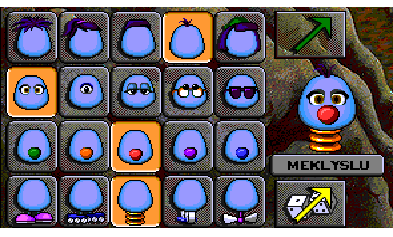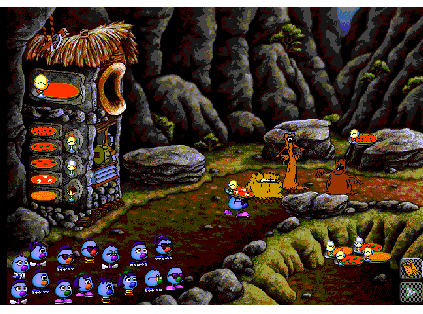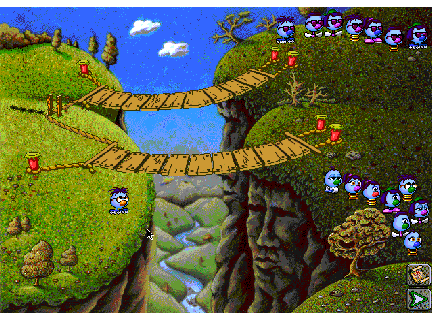Logical Zoombinis:
an adventure game for thinking
Steve Higgins and Nick Packard
Learning and Instruction Group
University of Newcastle upon Tyne
Logical
Journey of the Zoombinis is a captivating critical thinking program
designed around an escape story. The Zoombinis are a happy group
of creatures whose island is taken over by the Bloats. The player's
job is to help them in their escape. It is an unconventional mathematics
program, in that numbers and arithmetical operations do not play
much of an explicit role. Instead, this program focuses on the logic
and reasoning elements of mathematics: attributes, patterns, groupings,
sorting, comparisons, and problem solving. This may not be the current
focus for development in England and therefore hard to squeeze into
an overloaded school day. However the links with mathematical and
scientific reasoning, as well as with geography and history (are
the Zoombinis invaders or settlers?), or even the potential for
contributing to literacy, make the program justifiable for those
who see the value in it.
As mathematical creatures, the Zoombinis embody the powerful ideas
of attributes and combinations. Each Zoombini may have one of five
kinds of hairstyles, eyes or eyewear, nose colours, and feet or
footwear. Thus there is the possibility of forming 625 different
combinations. In their mathematical structures Zoombinis are similar
to records in a database, or base-5 numbers, and other mathematical
objects such as vectors. Zoombinis can therefore take part in many
mathematical processes related to data analysis, graphing, algebra,
and logic.
There are 625 possible combinations of attributes

Players must help the Zoombinis escape from Zoombini Isle and find
a new homeland. First you choose specific types of attributes for
each of the 16 escaping Zoombinis in your group. Once the team is
assembled they set out on a path that would make Indiana Jones tremble.
The Zoombinis confront a dozen obstacles that you must overcome
using deductive logic and creative reasoning. For example, the first
obstacle in their path is a pair of rope bridges at the Allergic
Cliffs. A guardian of these cliffs sneezes if a Zoombini with the
wrong attribute (or combination of attributes) tries to cross his
bridge. Make too many mistakes, and the bridge collapses. This requires
children to use sets and evidence to work out how to get all of
the Zoombinis across. Other activities include arranging the creatures
on a raft in a correct sequence, which develops comparison and pattern
skills; and hitching a ride on a toad placed on the correct shaped
or colour-coded lily pad to develop pattern identification and analysis.
A map is available for you to see where you have been and to try
puzzles in the practice mode.

At the hardest level you have to work out the likes and dislikes
of three pizza trolls with six pizza toppings and four ice cream
choices!
One of the more impressive features of this program is the potential
it has for repeated use, across a broad range of ages. Each of the
puzzles increases in complexity with each success. At the simplest
level five and six-year-olds can complete the puzzles. The hardest
levels of the hardest puzzles challenge adults! In practice mode
the program can be set at four levels of difficulty, which can be
useful for setting specific challenges to focus teaching particular
skills and accommodate different teaching and learning styles.
In the classroom
We
have used Zoombinis with different ages of pupils, from Year 3 to
Year 6. It has been successful on single machines as well as on
a network where a whole class used it (in pairs) on a weekly basis.
In general pupils collaborated well, though some needed encouragement
to share the mouse and to discuss and agree a course of action.
The program quickly becomes challenging to even the most able who
therefore found it useful to discuss what to do so that they did
not lose any Zoombinis. Successful pairings varied, with higher
attaining pupils sometimes being surprised at the ideas and suggestions
of friends usually less successful at more traditional tasks. The
level of motivation and task-related talk observed in all classes
was high.
Pupils' strategies
The more successful pupils used a combination of approaches. In
some of the puzzles you need to try something and risk making mistakes
in order to get feedback to work out what to do. In others, such
as Captain Cajun's ferryboat, you can plan a complete solution first.
It certainly seemed to help to get pupils to explain how to solve
the puzzles. Even some 'experts' found it difficult to articulate
why they were being successful.
Help strategies
A specific set
of help strategies was given to the children working with the program.
These were to:
Using help materials

The addictive appeal of the game is such that it is hard to get
pupils to use support materials while they are on the computer.
It was much more fun and engaging to play! Solving puzzles away
from the computer was one solution to this difficulty. For instance
by having a group of pupils use some of the activities in the teacher's
resource pack. This also helped to identify specific problems and
helped to make successful strategies clearer. In addition we designed
a series of help cards to support pupils' independent use of the
program. Although these were successful in helping them tackle the
problems, it was much harder to get them to record their attempts
to work out a solution. As a teacher, knowing when to intervene
directly is always difficult. Ideally probing questions can support
the pupils in structuring their ideas, but in practice this is hard
to do. In the end we decided that it was probably better to step
in after a brief interval and explain how to solve the puzzle then
see if the pupils had understood the approach the next time they
face a similar challenge. Of course knowing your pupils is also
essential, as some may request help too quickly. As the puzzles
are always different they need to understand principles rather than
solutions. Modelling a solution, or getting other pupils to demonstrate
a strategy, while explaining why it works seemed to be the most
helpful approach. Encouraging pupils to articulate their strategies
was easiest with the whole class arrangement, as it was possible
to begin and end sessions with a review or summary.
Challenges in teaching thinking
Each
puzzle offers four levels of challenge, and the difficulty level
automatically increases as player's master easier mathematics and
logic problems. Furthermore, all the puzzle solutions regenerate
with each attempt, so a player never faces the same puzzle twice.
The advantage of this is that you have to concentrate on principles
and strategies. It is possible to develop a shared language for
discussing strategies for problem solving with your class. Words
for talking about thinking help children to develop 'metacognitive
awareness', by which we mean not just thinking but thinking about
thinking.
The difficulty for the teacher is in knowing when to intervene.
Also, with a single computer used by two children at a time, it
is hard to justify interrupting your teaching to try work out a
solution and decide the best way to help. Most of the teachers using
it in this way expected pupils to manage on their own. Again the
help cards were useful in increasing independence, but some pupils
became frustrated at being unable to solve a puzzle without losing
lots of Zoombinis. Most children find it hard to grasp the idea
that mistakes can help you learn.

Which bridge should the last Zoombini cross and why?
Does it work?
The pupils we observed and worked with certainly became more skilful
at solving the problems in the software and more articulate in explaining
their strategies and solutions. The crucial question is does helping
the Zoombinis on their journey mean that these children will think
better in other situations? Is time spent with the Zoombinis going
to have an effect in their English lessons or on their capacity
to understand Mathematics? This kind of 'transfer' of learning from
one situation to another is always difficult to show. From our observations
the most important factor is the role played by the teacher. Teachers
can aid the 'transfer' of skills by making the thinking strategies
used with the Zoombinis more explicit and by drawing out connections
with different areas. For example the connection between problem
solving in the Zoombini world with questioning and hypothesising
in Science could be explained. Used in this way experience with
the Logical Journey of the Zoombinis can help to develop critical
thinking skills of the kind that are useful across the curriculum
and in many areas of life.
Steve Higgins and Nick Packard
University of Newcastle upon Tyne

